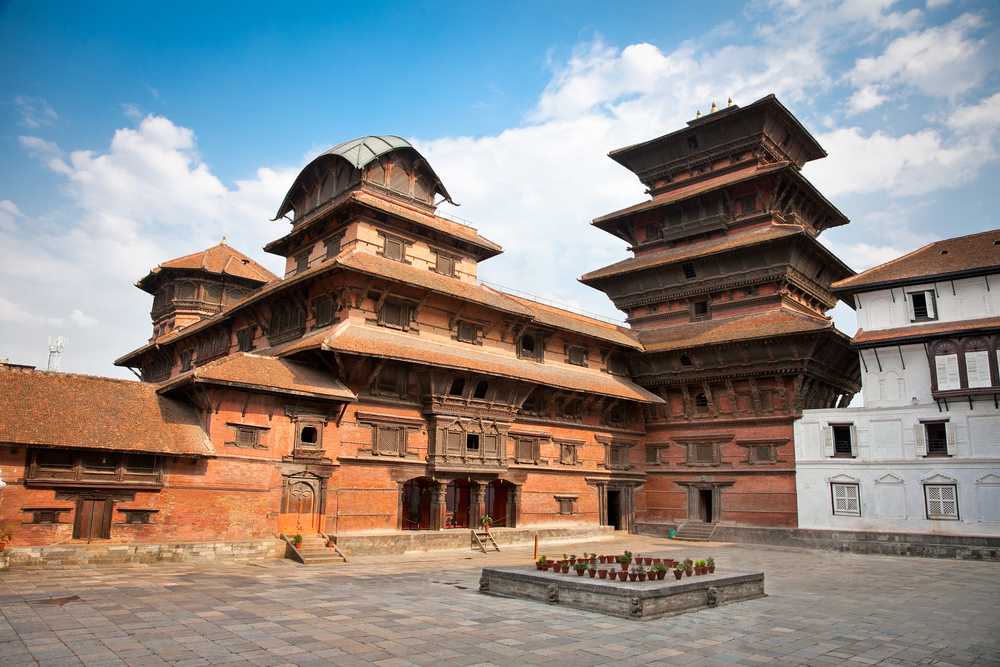

Hanuman Dhoka Palace, also known as Kathmandu Durbar Square, is a UNESCO World Heritage site, which once served as the residence for Nepal's royal family. The museum showcases artifacts that span over centuries, highlighting the rich history of the Kathmandu Valley and its rulers. Inside, you can find exquisite art, sculptures, and manuscripts, along with insights into the rituals and ceremonies of the former royal court. A tour here allows visitors to understand the political and cultural evolution of Nepal, with many sections of the palace featuring intricate woodcarvings and traditional Nepalese architecture.
Situated within the Hanuman Dhoka Palace area, Basantapur Tower offers a panoramic view of Kathmandu's skyline and the hustle and bustle of the ancient Basantapur square. Visitors climb narrow staircases to reach the balconies of the nine-story tower, providing a bird's eye view of the city. The tower itself is an architectural marvel, and while it suffered damage during the 2015 earthquake, restoration efforts have preserved much of its original grandeur. The experience encapsulates not just the tower but a part of Nepal's resilience and history.
The Kumari Bahal is a fascinating religious site within Hanuman Dhoka revered for housing the living goddess, or Kumari. The building is an example of the exquisite Newari architecture with its beautifully crafted wooden balconies and window carvings. Visitors can learn about the unique tradition of worshiping a prepubescent girl as a manifestation of divine female energy. The tour might not guarantee a sighting of the Kumari, as she appears at her discretion, but it provides a rare insight into a tradition that seamlessly melds the spiritual with the everyday life of Kathmandu's residents.
In the heart of Hanuman Dhoka lies the imposing statue of Kal Bhairav, representing a fierce manifestation of Lord Shiva. The deity is said to answer to crime and sin, with a fascinating history that mixes mythology with ancient legal practices; it was once believed that a liar would die upon lying in front of the statue. The statue's presence commands reverence and a bit of awe, and for those interested in mythological stories and cultural beliefs, it is a must-visit. It is also surrounded by smaller temples and stalls selling religious paraphernalia, immersing visitors in local spirituality.
Taleju Temple towers above Hanuman Dhoka and is one of the most sacred sites in Kathmandu. Built in the 16th century, this temple is dedicated to the goddess Taleju Bhawani and is an exemplary work of architectural brilliance with fine detailing on every corner. The temple is typically closed to the public except during certain festivals like Dashain, yet its grandeur from the outside is enough to captivate visitors. The courtyard offers a serene atmosphere, away from the urban chaos, for reflection and admiration of cultural craftsmanship.
Just a stone's throw away from the Hanuman Dhoka is Freak Street, officially known as Jhonchen Tole, which was the epicenter of the hippie movement in the 1960s and 1970s. Take a walk down this historic street and bask in the nostalgia; while the remnants of its psychedelic past have largely given way to cafes and souvenir shops, the atmosphere is still steeped in the countercultural vibes of its heyday. Visitors can enjoy the local food, purchase unique handicrafts, indulge in a cup of traditional Nepali tea, and learn about how this street played a significant role in Kathmandu's tourism boom.
Nasal Chowk is a courtyard within the Hanuman Dhoka palace complex, known for its historical and ceremonial importance. It holds a striking statue of Nasal, a form of Lord Vishnu, and several other deities. This location is often used for royal ceremonies, and when not in use, it's open to visitors. Surrounded by ancient art and architecture, the chowk provides a tranquil glance into the regal lifestyle of Nepal's monarchs and is an ideal spot for history enthusiasts who wish to savor a quiet moment amidst a wealth of Nepali culture.
To truly understand the historical significance and cultural heritage of Hanuman Dhoka, consider taking a guided heritage walk. Led by knowledgeable guides, these walks take you through the courtyards, temples, and alleys, unraveling the stories and legends that formed the fabric of Kathmandu's ancient history. With in-depth explanations of the rites, architecture, and significance of each location within the square, this tour is invaluable for those looking to immerse themselves in the culture and history of Nepal.
Adjacent to Hanuman Dhoka, the recently established Museum of Nepali Art (MoNA) presents a comprehensive array of Nepali artistic traditions. It contains hundreds of pieces, from sculptures and paintings to textiles, providing an expansive overview of the country’s artistic heritage. Visitors can explore the evolution of Nepali art and the influences that shaped its various forms over centuries. The museum is an excellent place for art enthusiasts to engage with the aesthetic expressions that portray Nepal’s diverse cultural landscape.
After exploring the historic landmarks, indulge in the local flavors by tasting traditional Newari cuisine at one of the many eateries around Hanuman Dhoka. Newari culture is notable for its culinary specialties, featuring items like momo (dumplings), yomari (sweet dumplings), and bara (savory lentil pancakes). A guided food tasting offers an opportunity to sample various dishes while learning about the ingredients, cooking techniques, and cultural significance behind each savory delight. The tasting not only satisfies the palate but also provides a cultural learning experience.
